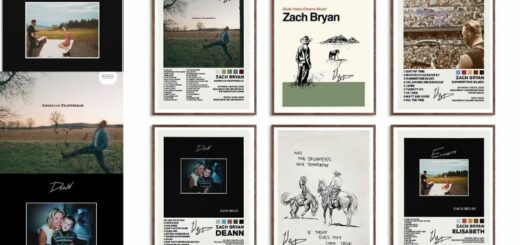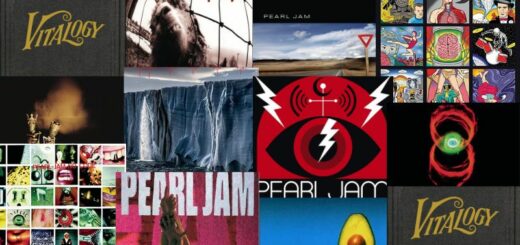The List of Jethro Tull Albums in Order of Release

Jethro Tull Albums in Order: With a blend of blues rock, jazz fusion, English folk, hard rock, and classical music, Jethro Tull, a British progressive rock band formed in Blackpool, Lancashire, in 1967, created a signature sound that defined progressive rock.
Jethro Tull is a legendary British progressive rock band that originated in Blackpool, Lancashire, in 1967. Known for their eclectic blend of blues rock, jazz fusion, English folk, hard rock, and classical music, Jethro Tull quickly carved out a unique sound in the progressive rock genre. The band’s founder, lead vocalist, bandleader, and principal composer is Ian Anderson, renowned for his distinctive flute playing and acoustic guitar skills.
Throughout its history, Jethro Tull has seen numerous lineup changes, with Anderson being the only constant member. The band has featured notable musicians such as guitarists Mick Abrahams and Martin Barre, bassists Glenn Cornick, Jeffrey Hammond, John Glascock, Dave Pegg, and Jonathan Noyce, drummers Clive Bunker, Barrie “Barriemore” Barlow, and Doane Perry, and keyboardists John Evan, Dee Palmer, Peter-John Vettese, and Andrew Giddings. Jethro Tull gained initial recognition in the London club scene and released their debut album, “This Was,” in 1968. Their second album, “Stand Up” (1969), marked a shift towards folk-influenced rock and achieved commercial success, reaching No. 1 in the UK.
The band’s sound continued to evolve, delving into progressive rock with albums like “Aqualung” (1971), “Thick as a Brick” (1972), and “A Passion Play” (1973), before exploring contemporary folk rock in the late 1970s and early 1980s with albums such as “Songs from the Wood” (1977), “Heavy Horses” (1978), and “Stormwatch” (1979). Jethro Tull’s musical versatility was further demonstrated as they ventured into electronic rock in the early 1980s with albums like “A” (1980), “The Broadsword and the Beast” (1982), and “Under Wraps” (1984). The band’s enduring popularity is evidenced by their estimated 60 million albums sold worldwide, with 11 gold and five platinum albums.
Notably, they won a Grammy Award for the 1987 album “Crest of a Knave,” showcasing their return to a hard rock style. While Jethro Tull ceased studio recording in the 2000s and officially split in 2011, Ian Anderson and Martin Barre continued to pursue solo careers. However, in 2017, Anderson revived the Jethro Tull name and released new studio albums in the 2020s, featuring a mix of musicians from the band’s original lineup and Anderson’s solo band. Jethro Tull’s legacy as one of the most commercially successful and innovative progressive rock bands remains unparalleled, solidifying their place in music history. So, if you are a die heart fan of Jethro Tull Albums then check out here we have list of Jethro Tull albums in order of release so far.
All Jethro Tull Albums Available on: Apple Music
How many albums does Jethro Tull have?
The discography of the British progressive rock band Jethro Tull have released 23 studio albums, 9 live albums, 15 Compilation albums, 12 Video albums, 4 EPs, and 33 Singles.
All Jethro Tull Albums in Order: Check Out The List of Jethro Tull Albums in Order of Release Here!
Here is the list of Jethro Tull Album in Order of Release Date
- This Was — 25 October 1968
- Stand Up — 1 August 1969
- Benefit — 20 April 1970
- Aqualung — 19 March 1971
- Thick as a Brick — 3 March 1972
- A Passion Play — 13 July 1973
- War Child — 14 October 1974
- Minstrel in the Gallery — 5 September 1975
- Too Old to Rock ‘n’ Roll: Too Young to Die! — 23 April 1976
- Songs from the Wood — 4 February 1977
- Heavy Horses — 10 April 1978
- Stormwatch — 14 September 1979
- A — 29 August 1980
- The Broadsword and the Beast — 10 April 1982
- Under Wraps — 7 September 1984
- Crest of a Knave — 11 September 1987
- Rock Island — 21 August 1989
- Catfish Rising — 10 September 1991
- Roots to Branches — 4 September 1995
- J-Tull Dot Com — 23 August 1999
- The Jethro Tull Christmas Album — 30 September 2003
- The Zealot Gene — 28 January 2022
- RökFlöte — 21 April 2023
All Jethro Tull Albums List in Order
1. This Was (1968)

Tracks
- My Sunday Feeling
- Some Day the Sun Won’t Shine for You
- Beggar’s Farm
- Move on Alone
- Serenade to a Cuckoo
- Dharma for One
- It’s Breaking Me Up
- Cat’s Squirrel
- A Song for Jeffrey
- Round
“This Was,” Jethro Tull’s debut studio album released in October 1968, marked a significant moment in the band’s history. Recorded on a modest budget of £1200, it stands as the only Jethro Tull album featuring guitarist Mick Abrahams, whose influence shaped the band’s early sound and style. At the time of its release, Jethro Tull was a regular performer at London’s Marquee Club, a venue renowned for hosting emerging British acts like the Rolling Stones and the Who. “This Was” reflects the band’s blues rock roots and laid the foundation for their later experimentation with progressive rock, setting the stage for their illustrious career.
2. Stand Up (1969)
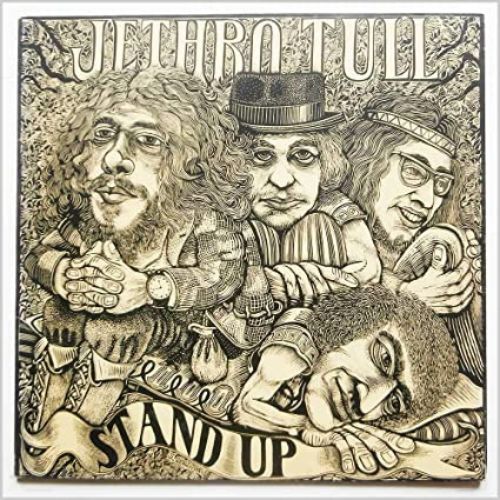
Tracks
- A New Day Yesterday
- Jeffrey Goes to Leicester Square
- Bourée
- Back to the Family
- Look into the Sun
- Nothing Is Easy
- Fat Man
- We Used to Know
- Reasons for Waiting
- For a Thousand Mothers
Stand Up, Jethro Tull’s second studio album, released in 1969, marked a pivotal moment in the band’s history. It introduced guitarist Martin Barre, who would remain a core member until 2012. This album also saw the departure of original guitarist Mick Abrahams due to creative differences with frontman Ian Anderson. Anderson took full control of the music and lyrics, resulting in an eclectic blend of styles and instrumentation. The album quickly soared to No. 1 on the UK charts, propelling Jethro Tull to new heights of success. The non-album single “Living in the Past” further solidified their popularity, reaching No. 3 on the charts. In the United States, Stand Up peaked at No. 20 on the Billboard 200, marking Jethro Tull’s breakthrough in the American music scene.
3. Benefit (1970)

Tracks
- With You There to Help Me
- Nothing to Say
- Alive and Well and Living In
- Son
- For Michael Collins, Jeffrey and Me
- To Cry You a Song
- A Time for Everything?
- Inside
- Play in Time
- Sossity; You’re a Woman
“Benefit” is the third studio album by the British rock band Jethro Tull, released in April 1970. The album marked the inclusion of pianist and organist John Evan, though he was not yet a full member. It was also the final album to feature bass guitarist Glenn Cornick, who was dismissed after the tour. Recorded at Morgan Studios, the band experimented with more complex recording techniques. Frontman Ian Anderson described “Benefit” as darker than its predecessor, “Stand Up,” attributing this to the pressures of touring and frustration with the music industry. The album showcases Jethro Tull’s evolving sound and lyrical depth, cementing its place in the band’s discography.
4. Aqualung (1971)

Tracks
- Aqualung
- Cross-Eyed Mary
- Cheap Day Return
- Mother Goose
- Wond’ring Aloud
- Up to Me
- My God
- Hymn 43
- Slipstream
- Locomotive Breath
- Wind-Up
“Aqualung,” the fourth studio album by British progressive rock band Jethro Tull, released on March 19, 1971, by Chrysalis Records, stands as a hallmark of the genre. Though the band denies a deliberate concept, it explores themes of religion and societal struggles. Recorded at Island Records’ London studio, it introduced keyboardist John Evan and bassist Jeffrey Hammond, while marking drummer Clive Bunker’s departure. Departing from previous work, “Aqualung” incorporates more acoustic elements, influenced by Ian Anderson’s observations of homelessness. With over seven million copies sold worldwide, it remains their best-selling album, praised by critics and spawning hits like “Hymn 43” and “Locomotive Breath.”
5. Thick as a Brick (1972)
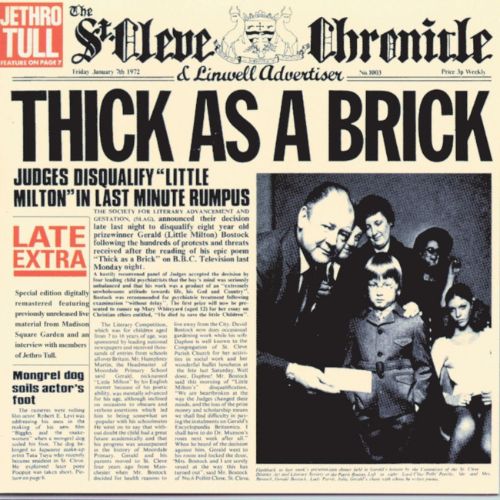
Tracks
- Thick as a Brick, Part I
- Thick as a Brick, Part II
“Thick as a Brick,” the fifth studio album by British rock band Jethro Tull, is a landmark in progressive rock history. Released on March 3, 1972, the album features one continuous piece of music, cleverly parodying the concept album genre. Packaged as a 12-page newspaper, the album presents itself as a musical adaptation of an epic poem by fictional child prodigy Gerald Bostock, though the lyrics were penned by frontman Ian Anderson. Recorded in late 1971, the album marked the debut of drummer Barrie “Barriemore” Barlow. Despite mixed initial reviews, “Thick as a Brick” became a commercial success, topping charts in 1972 and solidifying its status as a progressive rock classic.
6. A Passion Play (1973)

Tracks
- A Passion Play, part I
Act 1: Ronnie Pilgrim’s Funeral
• Lifebeats
• Prelude
• The Silver Cor
• Re-Assuring TuneAct 2: The Memory Bank
• Memory Bank
• Best Friends
• Critique Oblique
• Forest Dance #1Interlude: The Story of the Hare Who Lost His Spectacles
• The Story of the Hare Who Lost His Spectacles - A Passion Play, part II
Interlude: The Story of the Hare Who Lost His Spectacles
• The Story of the Hare Who Lost His SpectaclesAct 3: The Business Office of G. Oddie & Son (two days later)
• Forest Dance #2
• The Foot of Our Stairs
• Overseer OvertureAct 4: Magus Perdé’s Drawing Room at Midnight
• Flight from Lucifer
• 10:08 to Paddington
• Magus Perdé
• Epilogue
“A Passion Play,” the sixth studio album by British progressive rock band Jethro Tull, released in July 1973, follows the conceptual style of its predecessor, “Thick as a Brick” (1972). Structured as a continuous piece of music split into two parts, the album tells the story of Ronnie Pilgrim’s journey in the afterlife, exploring themes of morality, religion, and good versus evil. Despite initial critical backlash, the album was a commercial triumph, becoming Jethro Tull’s second number one album in the United States. The accompanying tour, noted for its elaborate stage productions, further solidified “A Passion Play” as a pivotal moment in the band’s career.
7. War Child (1974)
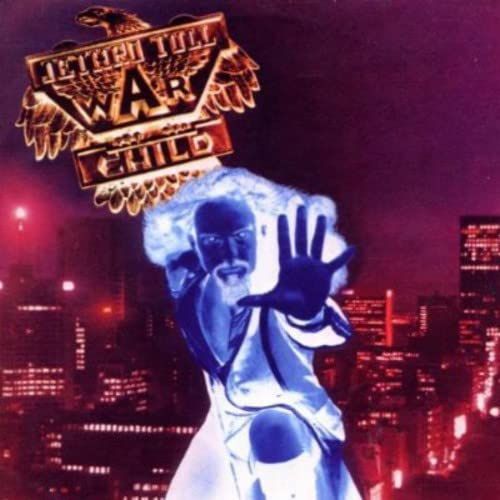
Tracks
- War Child
- Queen and Country
- Ladies
- Back-Door Angels
- Sealion
- Skating Away on the Thin Ice of the New Day
- Bungle in the Jungle
- Only Solitaire
- The Third Hoorah
- Two Fingers
War Child, Jethro Tull’s seventh studio album, was released in October 1974, following a tumultuous period of criticism surrounding their previous album, A Passion Play. The band faced scrutiny and had to address their plans for the future in press conferences. War Child showcases Jethro Tull’s distinctive blend of progressive rock, folk, and hard rock elements, featuring intricate compositions and Ian Anderson’s signature flute playing. Despite the challenges during its production, War Child received critical acclaim and commercial success, further solidifying Jethro Tull’s status as one of the pioneering bands in the progressive rock genre.
8. Minstrel in the Gallery (1975)
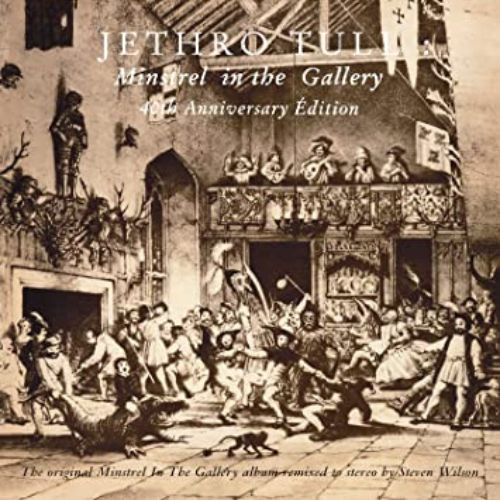
Tracks
- Minstrel in the Gallery
- Cold Wind to Valhalla
- Black Satin Dancer
- Requiem
- One White Duck / 010 = Nothing at All
- Baker St. Muse
• Pig-Me and the Whore
• Nice Little Tune
• Crash-Barrier Waltzer
• Mother England Reverie - Grace
Minstrel in the Gallery, the eighth studio album by Jethro Tull, released in September 1975, marked a return to the band’s earlier electric and acoustic blend after the experimental War Child (1974). The album, reminiscent of their early 1970s sound from Benefit (1970), Aqualung (1971), and Thick as a Brick (1972), was recorded in Monte Carlo using a newly constructed mobile studio. It was the last album to feature bassist Jeffrey Hammond, who left after the tour, being replaced by John Glascock. Minstrel in the Gallery showcases Jethro Tull’s ability to evolve while maintaining their signature sound and was well-received by fans and critics alike.
9. Too Old to Rock ‘n’ Roll: Too Young to Die! (1976)

Tracks
- Quizz Kid
- Crazed Institution
- Salamander
- Taxi Grab
- From a Dead Beat to an Old Greaser
- Bad-Eyed and Loveless
- Big Dipper
- Too Old to Rock ‘n’ Roll: Too Young to Die
- Pied Piper
- The Chequered Flag (Dead or Alive)
“Too Old to Rock ‘n’ Roll: Too Young to Die!” is Jethro Tull’s ninth studio album, recorded in December 1975 and released in 1976. Bassist John Glascock, who also provides backing vocals, made his debut with the band on this album. It is the last Jethro Tull concept album, telling the story of Ray Lomas, an aging rocker navigating changing musical trends. Despite critical acclaim, the album did not achieve Gold certification, making it their only 1970s release not to do so. Nonetheless, “Too Old to Rock ‘n’ Roll: Too Young to Die!” remains a unique and memorable entry in Jethro Tull’s discography.
10. Songs from the Wood (1977)
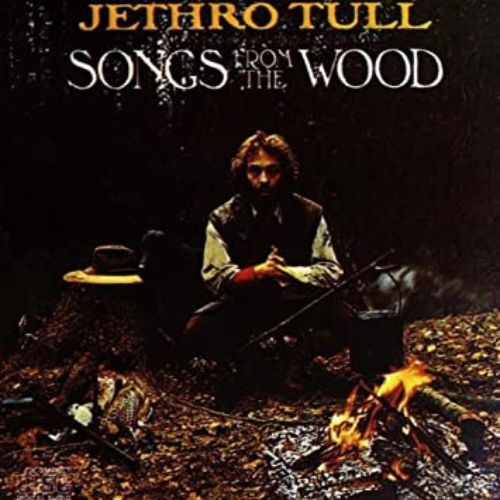
Tracks
- Songs from the Wood
- Jack-in-the-Green
- Cup of Wonder
- Hunting Girl
- Ring Out, Solstice Bells
- Velvet Green
- The Whistler
- Pibroch (Cap in Hand)
- Fire at Midnight
“Songs from the Wood” is the tenth studio album by British progressive rock band Jethro Tull, released on 11 February 1977 by Chrysalis Records. It marks the beginning of a trilogy of folk rock albums from the band, followed by “Heavy Horses” (1978) and “Stormwatch” (1979). Inspired by English folklore and rural life, the album blends traditional instruments and melodies with hard rock drums, synthesisers, and electric guitars within the band’s complex progressive rock style. It also marks the official inclusion of Dee Palmer as a second keyboardist. “Songs from the Wood” was well-received by critics, seen as a return to form for Jethro Tull after a series of less successful albums.
11. Heavy Horses (1978)
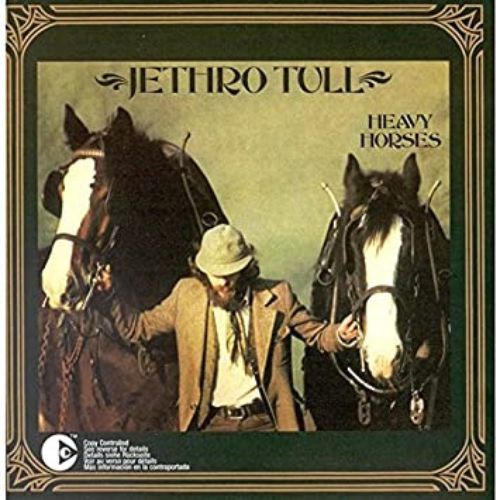
Tracks
- …And the Mouse Police Never Sleeps
- Acres Wild
- No Lullaby
- Moths” 3:24 5. “
- Journeyman
- Rover
- One Brown Mouse
- Heavy Horses
- Weathercock
“Heavy Horses,” the eleventh studio album by British progressive rock band Jethro Tull, released on April 10, 1978, is often regarded as the second installment in a trio of folk rock albums from the late 1970s, alongside “Songs from the Wood” (1977) and “Stormwatch” (1979). Departing from the British folklore themes of its predecessor, “Heavy Horses” embraces a more realistic portrayal of country life, paying homage to the working ponies and horses of Great Britain. Musically, the album maintains the folk-progressive rock fusion of “Songs from the Wood,” but with a darker, more somber tone that reflects its lyrical shift.
12. Stormwatch (1979)

Tracks
- North Sea Oil
- Orion
- Home
- Dark Ages
- Warm Sporran
- Something’s on the Move
- Old Ghosts
- Dun Ringill
- Flying Dutchman
- Elegy
Stormwatch, the twelfth studio album by Jethro Tull, marks the end of a folk rock trilogy alongside Songs from the Wood and Heavy Horses. Released in September 1979, the album’s themes delve into environmental concerns, climate, and coastal life, drawing inspiration from Ian Anderson’s new property on the Isle of Skye, Scotland. This album is significant as it was the final one to feature the “classic” 1970s lineup, with drummer Barrie “Barriemore” Barlow, keyboardists John Evan and Dee Palmer departing after the 1980 tour. Additionally, bassist John Glascock’s contributions were limited due to health issues, prompting Anderson to handle bass duties on most tracks.
13. A (1980)

Tracks
- Crossfire
- Fylingdale Flyer
- Working John, Working Joe
- Black Sunday
- Protect and Survive
- Batteries Not Included
- Uniform
- 4.W.D. (Low Ratio)
- The Pine Marten’s Jig
- And Further On
“A” is the 13th studio album by British rock band Jethro Tull, released on August 29, 1980, in the UK and on September 1 in the US. Initially intended as frontman Ian Anderson’s solo debut (hence the title “A,” for Anderson), pressure from Chrysalis Records led to its release as a Jethro Tull album. Musically, “A” departed from the band’s previous works, embracing an electronic rock sound with heavy synthesizers while maintaining folk influences and Anderson’s flute. Lyrically, it focused on contemporary themes like the Cold War, a shift from Tull’s earlier fantasy themes. The album featured new band members following a major lineup change, including Dave Pegg on bass, Mark Craney on drums, and Eddie Jobson on keyboards and electric violin.
14. The Broadsword and the Beast (1982)

Tracks
- Beastie
- Clasp
- Fallen On Hard Times
- Flying Colours
- Slow Marching Band
- Broadsword
- Pussy Willow
- Watching Me, Watching You
- Seal Driver
- Cheerio
“The Broadsword and the Beast” is the 14th studio album by Jethro Tull, released in April 1982 by Chrysalis Records. This album blends the dominant synthesizer sound of the 1980s with Jethro Tull’s folk-influenced style from the previous decade, combining acoustic instrumentation with electronic soundscapes. Produced by Paul Samwell-Smith, it was the band’s first album with an external producer. Early sessions were produced by Keith Olsen but were later dismissed. The album also marked the debut of keyboardist Peter-John Vettese and drummer Gerry Conway. This exploration of electronic elements would continue on Jethro Tull’s next album, “Under Wraps” (1984), and Ian Anderson’s solo album, “Walk into Light” (1983).
15. Under Wraps (1984)

Tracks
- Lap of Luxury
- Under Wraps #1
- European Legacy
- Later, That Same Evening
- Saboteur
- Radio Free Moscow
- Nobody’s Car
- Heat
- Under Wraps #2
- Paparazzi
- Apogee
“Under Wraps,” Jethro Tull’s 15th studio album, released in 1984, explores espionage themes, reflecting Ian Anderson’s fascination with spy fiction. Its electronic/synthesizer-based sound, including the controversial use of electronic drums, divided fans. Dave Pegg suggested that tracks cut from the “Broadsword and the Beast” sessions would have improved the album, yet Martin Barre considers it one of his favorite Tull albums. Despite mixed reactions, “Under Wraps” reached No. 76 on the Billboard 200 and No. 18 on the UK Albums Chart. The single “Lap of Luxury” achieved moderate success, peaking at No. 30.
16. Crest of a Knave (1987)

Tracks
- Steel Monkey
- Farm on the Freeway
- Jump Start
- She Said She Was a Dancer
- Budapest
- Mountain Men
- Raising Steam
“Crest of a Knave” is the sixteenth studio album by British rock band Jethro Tull, released in 1987. Recorded after a hiatus due to vocalist Ian Anderson’s throat infection, the album marked a return to hard rock after the less successful “Under Wraps.” It became their most successful album since the 1970s, leading to a resurgence in radio play, MTV appearances, and critical acclaim. It famously won the 1989 Grammy Award for Best Hard Rock/Metal Performance Vocal or Instrumental, beating out Metallica’s “…And Justice for All.” Supported by “The Not Quite the World, More the Here and There Tour,” the album solidified Jethro Tull’s status as rock icons.
17. Rock Island (1989)
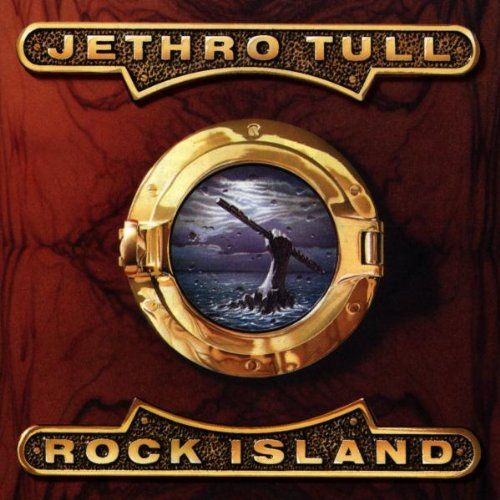
Tracks
- Kissing Willie
- The Rattlesnake Trail
- Ears of Tin
- Undressed to Kill
- Rock Island
- Heavy Water
- Another Christmas Song
- The Whaler’s Dues
- Big Riff and Mando
- Strange Avenues
Rock Island, Jethro Tull’s 17th studio album, released in 1989, continued the band’s hard rock direction from Crest of a Knave (1987). The lineup featured Ian Anderson, Martin Barre, Dave Pegg, and drummer Doane Perry in his first full recording. The album went Gold in the UK and peaked at No. 5 in Germany. “Kissing Willie” was a notable hit, reaching No. 6 on the US Mainstream Rock Chart. The 1989 tour showcased innovative staging, including projected silhouettes of dancers during “Kissing Willie.” Tracks like “Big Riff and Mando” offered humorous insights into the band’s touring life, recounting the theft of Barre’s mandolin by an enthusiastic fan.
18. Catfish Rising (1991)
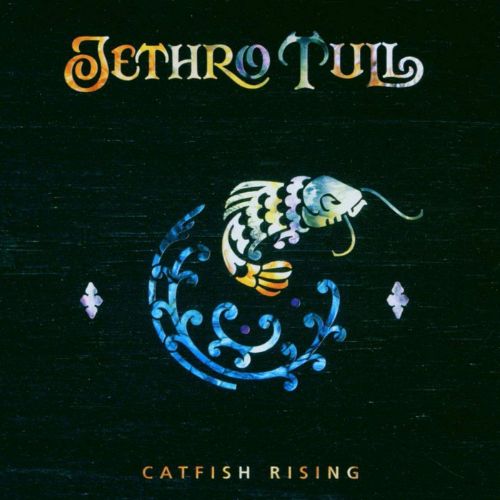
Tracks
- This Is Not Love
- Occasional Demons
- Rocks on the Road
- Thinking Round Corners
- Still Loving You Tonight
- Doctor to My Disease
- Like a Tall Thin Girl
- Sparrow on the Schoolyard Wall
- Roll Yer Own
- Gold-Tipped Boots, Black Jacket and Tie
“Catfish Rising,” the 18th studio album by British rock band Jethro Tull, released on September 10, 1991, marked a significant addition to the band’s lineup with keyboardist Andrew Giddings. Following the hard rock and blues direction of its predecessors, the album showcases Jethro Tull’s continued evolution of their sound. With tracks like “This Is Not Love” and “Rocks on the Road,” “Catfish Rising” demonstrates the band’s prowess in blending rock with folk influences. The album’s release was met with favorable reviews, further solidifying Jethro Tull’s status as pioneers in the progressive rock genre, appealing to both existing fans and new listeners alike.
19. Roots to Branches (1995)

Tracks
- Roots to Branches
- Rare and Precious Chain
- Out of the Noise
- This Free Will
- Valley
- Dangerous Veils
- Beside Myself
- Wounded, Old and Treacherous
- At Last, Forever
- Stuck in the August Rain
- Another Harry’s Bar
“Roots to Branches,” the 19th studio album by British band Jethro Tull, released in September 1995, blends the band’s classic 1970s progressive rock and folk rock roots with jazz, Arabic, and Indian influences. All songs were penned by Ian Anderson and recorded at his home studio. This marks the last Tull album with Dave Pegg on bass and the first with keyboardist Andrew Giddings as an official member. Notably, the album features the longest-serving lineup in Jethro Tull’s history. It was also their final album under long-time label Chrysalis Records. A remastered edition was released in January 2007.
20. J-Tull Dot Com (1999)

Tracks
- Spiral
- Dot Com
- AWOL
- Nothing @ All
- Wicked Windows
- Hunt by Numbers
- Hot Mango Flush
- El Niño
- Black Mamba
- Mango Surprise
- Bends Like a Willow
- Far Alaska
- The Dog-Ear Years
- A Gift of Roses
J-Tull Dot Com, the 20th studio album by British band Jethro Tull, was released in 1999 on Papillon, the Chrysalis Group’s heritage record label. Following their 1995 album Roots to Branches, this release continued the band’s blend of hard rock with Eastern music influences. It marked Jonathan Noyce’s debut on bass, maintaining the band’s longest unchanged lineup until 2007. This album was the band’s last to feature all original new material for 23 years until The Zealot Gene in 2022. Although they did release a Christmas album in 2003, it featured a mix of new songs, re-recordings, and traditional Christmas music arrangements.
21. The Jethro Tull Christmas Album (2003)
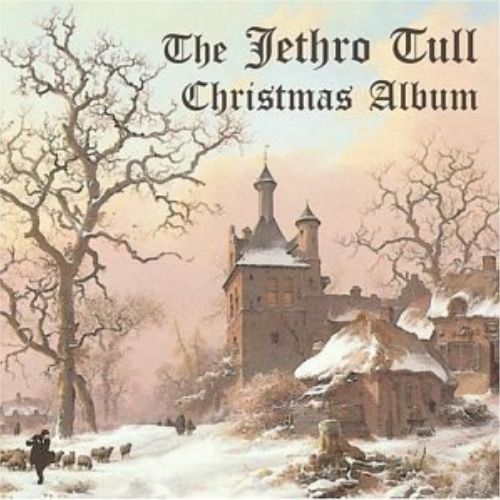
Tracks
- Birthday Card at Christmas
- Holly Herald
- A Christmas Song
- Another Christmas Song
- God Rest Ye Merry, Gentlemen
- Jack Frost and the Hooded Crow
- Last Man at the Party
- Weathercock
- Pavane
- First Snow on Brooklyn
- Greensleeved
- Fire at Midnight
- We Five Kings
- Ring Out Solstice Bells
- Bourée
- A Winter Snowscape
The Jethro Tull Christmas Album, released on September 30, 2003, marks the band’s 21st studio album and their final studio release for nearly two decades, until The Zealot Gene in 2022. It features the lineup of Ian Anderson, guitarist Martin Barre (in his last album with the group), bassist Jonathan Noyce, keyboardist Andrew Giddings, and drummer Doane Perry. The album showcases Jethro Tull’s unique take on Christmas classics, blending their signature progressive rock style with holiday cheer. This album serves as a testament to the band’s enduring creativity and musical versatility, capping off a chapter in their illustrious career.
22. The Zealot Gene (2022)

Tracks
- Mrs. Tibbets
- Jacob’s Tales
- Mine Is the Mountain
- The Zealot Gene
- Shoshana Sleeping
- Sad City Sisters
- Barren Beth, Wild Desert John
- The Betrayal of Joshua Kynde
- Where Did Saturday Go?
- Three Loves, Three
- In Brief Visitation
- The Fisherman of Ephesus
“The Zealot Gene,” Jethro Tull’s 22nd studio album, released on 28 January 2022 by Inside Out Music, marks their return to original material after nearly two decades. With a production span of almost five years, it follows their last studio album, “J-Tull Dot Com” (1999), and their first since “The Jethro Tull Christmas Album” (2003), signifying the longest gap between their studio releases. The album debuted at number 9 on the UK Albums Chart, marking Jethro Tull’s first top ten album in the UK since 1972. This release reaffirms the band’s enduring legacy and musical prowess, captivating audiences with their distinct blend of progressive rock.
23. RökFlöte (2023)

Tracks
- Voluspo
- Ginnungagap
- Allfather
- The Feathered Consort
- Hammer On Hammer
- Wolf Unchained
- The Perfect One
- Trickster (And The Mistletoe)
- Cornucopia
- The Navigators
- Guardian’s Watch
- Ithavoll
“RökFlöte,” the 23rd studio album by British progressive rock band Jethro Tull, was released on April 21, 2023, as a follow-up to “The Zealot Gene” (2022). This album marks the shortest gap between Jethro Tull studio albums since 1980, showcasing the band’s continued creativity and productivity. With its release, Jethro Tull continues to push the boundaries of their signature sound, incorporating elements of blues rock, jazz fusion, English folk, hard rock, and classical music. “RökFlöte” further cements Jethro Tull’s legacy as one of the most influential and enduring bands in the progressive rock genre, captivating audiences with their innovative musicality and storytelling.
Thanks for Visit!

